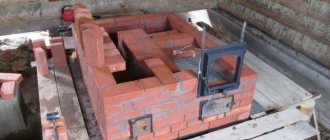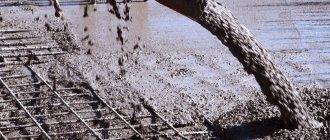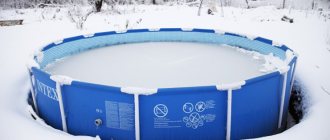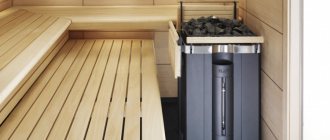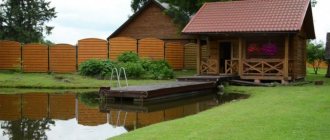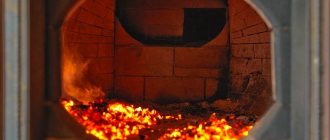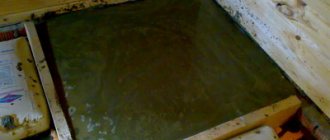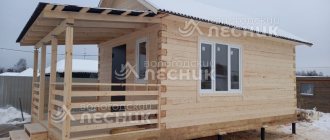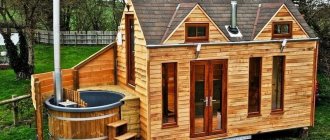Winter construction is quite a complicated matter and not always justified. Frosts, snowfalls, inconveniences and even the impossibility of carrying out certain types of work force many to wait until summer. However, some activities can be carried out in winter, the main thing is to work in relatively warm (not lower than 5...7 degrees below zero) weather and follow the rules. These activities include pouring the foundation in winter.
What happens to concrete at low temperatures?
The process of concrete hardening, or, as builders and engineers also say, the development of design strength, is the result of the gradual loss of water molecules from the solution. The duration of hardening largely depends on the composition of the solution (see Table 1), but the ambient temperature influences the process even more.
Depending on the temperature, it can acquire brand strength in 14 or more days, and the colder the air - and the concrete mass - the longer it will take to gain full strength.
If the weather intervened in the hydration process and the water in the concrete mixture simply froze, then the removal of molecules from the concrete occurs only after thawing. Repeated freeze-thaw cycles have a very bad effect on the final quality of the foundation, since complete curing may not occur.
At the same time, for frozen and then thawed concrete, the strength gain is faster and more uniform, the later the mixture freezes.
The graph shows the curves: 1. non-frozen concrete; 2. the mixture froze on the seventh day from the moment of pouring; 3. the concrete froze on the third or fourth day after pouring; 4. freezing occurred on the first day after concreting.
If we consider temperatures from +5 to -3 degrees Celsius as “winter conditions”, then it is possible to fill the foundation in winter. If we take the more typical temperature for our country at 10 degrees below zero, we will have to postpone construction work or, at a minimum, use special additives.
Antifreeze additives for concrete
When planning to pour a foundation in winter, you need to think in advance about special additives to the concrete mixture - hardening accelerators and anti-freeze additives.
Depending on the type of additive, the freezing temperature of the concrete mixture changes, decreasing.
These additives are available in powder and liquid form; the percentage in concrete depends on the ambient temperature and the composition of the additive.
For comparison, data on three types of additives are presented.
Increasing the additive percentage above 4 usually has no effect.
Why increase the water resistance of concrete?
The higher the water resistance of concrete, the less susceptible it is to water pressure, as well as the effects of chemically aggressive substances in the soil and groundwater: acids, alkalis, salts, and so on. The water permeability of concrete is negatively affected by excess mixing water, undercompaction of the concrete mixture and lack of maintenance of freshly laid concrete.
Water that has not entered into the hydration of cement (the so-called transformation of a plastic mass into a monolith) forms pores in the concrete after evaporation. Some of them are not closed and form end-to-end channels. Moisture penetrates through them into the foundation, which expands when freezing, which contributes to the further destruction of concrete.
To reduce the amount of mixing water while maintaining the mobility of the concrete mixture, plasticizers are used. They reduce the water-cement ratio, reduce the pore volume in concrete and increase its density. It should be taken into account that it is necessary to select the composition of a specific concrete mixture in laboratories, taking into account the features and characteristics of the materials used: cement, coarse and fine aggregates and various additives.
During installation, special attention is paid to compacting the concrete. The concrete mixture must completely fill the required space without creating voids. This is especially important with dense reinforcement of the structure. For these purposes, special devices are used - deep and surface vibrators.
Working conditions: is it possible to pour a foundation for a house in winter or prepare for it?
Pouring concrete into the formwork is the final stage of the process; before this, it is necessary to perform a number of actions that are greatly hampered by frost and slush during thaws:
- site marking;
- excerpt of the pit;
- installation of a sand and gravel cushion;
- installation of formwork.
The first and last stages are relatively simple and can be performed with little regard to weather conditions. But even formwork installed in melted snow or on wet soil will behave poorly - it will swell, warp, and will subsequently release the accumulated moisture to the concrete (we are, of course, talking about the commonly used formwork made of wooden boards).
But digging out a pit is very difficult: in cold weather, the soil needs to be warmed up for easy removal; in the thaw, you will have to tinker in the mud and shovel out the melted snow. The design of the pillow will also encounter problems. It is inconvenient to pour crushed stone and sand onto soil saturated with moisture - they “sink” in the soggy soil. By placing a pillow on frozen ground, you may encounter “drowning” later, during a thaw.
It is advisable to excavate the pit and install the cushion before the onset of rain and frost, and compact the cushion as thoroughly as possible.
If this cannot be done and the work is carried out in winter, you should:
- warm up the frozen soil until it can be dug using a mechanized method (heat guns, fires);
- If possible, dry the bottom and walls of the pit;
- lay the pillow and, after compacting, warm it up, then compact it again if necessary;
- Before pouring concrete, warm up the installed formwork and pad to the temperature of the mixture being poured or a little more.
Warming up and maintaining the required temperature will be significantly easier when installing a greenhouse over the future foundation - a tent or closed-type panel structure made of film, sheet materials (plywood, OSB, etc.). The efficiency of the greenhouse is significantly increased by heat-reflecting panels or films on the inside of the shelter.
The greenhouse structures are installed so that the formwork can be heated evenly from all sides.
Bottom line
The optimal time for pouring the foundation in most regions of Russia, except the northern ones, is the second half of spring or early summer. During this period, the optimal weather for concreting work is established. Here are the main points to pay attention to when conducting them:
- Entrust the work of decoupling the reinforcement frame and concreting to a specialized organization. This way you will avoid mistakes, the correction of which can be very expensive.
- Use only ready-mixed concrete of appropriate strength and water resistance grades. Methods of preparing concrete on site in a metal bath and using shovels are strictly unacceptable.
- Carry out concrete work without forming cold joints.
- Increase the water resistance of concrete using special additives. For example, penetrating.
- Freshly laid concrete needs to be maintained. Cover it with damp burlap and water it every two or three hours, even at night, for 3 to 5 days. If the weather is hot, it is better to water within 7 days.
- Carry out foundation work in winter using special methods.
- If possible, check the thickness of the concrete cover using a rebar locator. It must be at least 15 mm.
- Additionally, protect foundation structures from the negative effects of soil and groundwater.
How to pour a foundation in winter: methods for aging the mixture
Antifreeze additives and careful preparation of the foundation pit/formwork alone are not enough for normal concrete hardening. It is necessary to maintain the required temperature and humidity conditions during the hardening process of the material.
When introducing additives into the mixture to accelerate hardening, the temperature of the concrete mass should be maintained at +10...+15 degrees for 1...1.5 days or not lower than +5 degrees for 2...3 days.
Depending on the surface modulus, that is, the ratio of the external (in contact with the outside air) area to the volume of the poured mass, the most rational method of maintaining structures is chosen.
Thermos method
It consists of maintaining the desired temperature of the concrete mixture until it reaches critical strength with the help of covering materials. Thick polymer film, bitumen sheets, roofing felt, and tarpaulin are used as such materials. You can also use mats, felt, polystyrene and foam plastic for insulation, but in this case a frame is required for laying the insulation and careful sealing of the cracks. Bulk heat insulators are laid on top of film-roll materials and protected from the wind with shields or a second layer of film/tarpaulin.
It is believed that the minimum temperature at which a foundation can be poured using the thermos method should be within the range of 0...-10 degrees at night and at least 0 during the day.
Features of the method:
- the formwork must be pre-insulated (or the insulation materials are prepared so that they are installed as they are poured);
- formwork and reinforcement are cleared of ice and snow, dried and heated using steam or heat guns;
- the supplied mixture is heated to a temperature above standard and immediately, within no more than 1.5 hours, poured with obligatory vibrating rammer;
- Open surfaces are immediately covered and thermally insulated after pouring.
It is possible to pour a foundation in winter at sub-zero temperatures using the “thermos” method only based on the results of a thermal engineering calculation - the ability of the mixture to gain critical strength at a given initial temperature of the concrete and selected insulating materials must be confirmed.
Pouring the heated mixture
How to pour a foundation in winter with heating
To do this, as already mentioned, it is necessary to pre-mount the greenhouse. Heat can be supplied to the working volume in two ways:
- air heating - heat guns, steam. Steam or air, heated to a temperature of 100...120 degrees, is supplied to the open surfaces of the concrete, to all surfaces of the formwork. The more uniformly the heating occurs, the faster the concrete gains strength. In favorable conditions, it is possible to gain critical strength in 1…2 days;
| Ambient temperature, degrees Celsius | Rated power of the heat gun, kW per 100 sq.m of heated area | Gas consumption, liters per day |
| Up to 15 | 10 | 16…20 |
| Below -15 | 30 | 60…70 and more |
| Under these conditions, the temperature inside the greenhouse is positive, about 2...5 degrees Celsius | ||
- electrical heating. There are through and peripheral heating. In the first case, rod or string electrodes are laid inside the formwork, and the current passing through them heats the entire mass of concrete. In the second case, strip electrodes are laid on the surface of the foundation, and heating occurs due to the thermal conductivity of the concrete.
String electrodes inside the formwork
Rod external electrodes with connected generator
Important: when using electrical heating, it is necessary to take into account the presence of anti-frost additives in the concrete! With them, the conductivity of the mixture increases up to two times; accordingly, it is necessary to reduce the current strength.
Below are diagrams of the location of electrodes in different structures during concreting and diagrams of their connection.
Possible consequences of winter concreting
Failure to comply with concrete laying technologies in winter results in concrete products of reduced strength, with cracks, efflorescence and other defects, as well as poor adhesion to reinforcement. The products are short-lived in use.
Important!
It should be remembered that the critical strength of concrete is 30–50% of the design strength, and stripping - 70%. Once concrete reaches critical strength, frost no longer harms it, and heating measures can be curtailed. But at this moment it is still impossible to strip the formwork and put a load on the concrete.
Concrete work in winter is most often a necessary measure, but even in this case there are advantages. When choosing a technology for winter work, many factors are taken into account: the type of structures, the composition of the concrete mixture, the availability of equipment and the economic effect of their use. Antifreeze additives are desirable for use when choosing any method of conducting concrete work in winter.
Foundation in winter: is it possible to make the event profitable?
One of the arguments in favor of winter construction, in particular the installation of a foundation, is considered to be cost savings. However, this is a complex question; let’s look at it in more detail.
| Plus | Minus |
| Labor costs for workers are actually lower, since construction crews are idle and are ready to reduce prices | To live on site, they need to be provided with warm cabins, delivery/cooking of hot food, and normal living conditions; |
| Construction stores and warehouses offer discounts on cement and other materials | Costs for frost-resistant additives, installation of a warming house or “thermos”, heating of the concrete mass will “eat up” the saved money |
| The loose soil in the pit does not crumble, groundwater does not interfere with digging the pit | It will not be possible to dig a pit manually even when warming up; you will need to hire equipment. Groundwater can “manifest itself” during a thaw, turning the pit into a swamp |
| Work on the site does not disturb anyone - there are almost no residents in the holiday villages | The transportation of materials, products, and people is difficult; in bad weather, work has to be stopped, crews and equipment are idle |
| Construction time will be reduced, the project can be quickly completed in the spring | If the technology for pouring the foundation is not fully maintained, insufficient structural strength and rework are possible. |
In conclusion, I would like to say - despite the fact that the foundation can be poured in winter, it is better to postpone the “zero cycle” work until the warm season and not risk the integrity and reliability of the future home!
Are there any advantages to winter concrete work?
In general, working with concrete in harsh conditions of low temperatures entails additional difficulties, but it is impossible to stop construction for six months every time autumn comes, and besides, winter work also has significant advantages:
- Winter discounts on building materials and the decline in demand for labor make it possible to save money.
- In winter, foundations can be concreted on weak or brittle soil.
- Frozen access roads make it possible to easily deliver heavy equipment and materials to a construction site.
Warming up the pit
The hydration reaction is possible at temperatures above +5°C. Therefore, cooling of the concrete mixture below this indicator should not be allowed.
Preparation for installation begins with heating the pit. In the conditions of individual private construction, open-flame fires, reflector stoves, thermomats, hot coolants - sand, slag - are used.
The hardest thing is to prepare the foundation pit for the slab foundation. A large area of soil heats up slowly and cools down quickly. But it is much easier to warm the trenches under the strip base. The route can be prepared not entirely, but in parts, and monolithic work can also be carried out in separate sections.
Supplements
To prolong the liquid phase and speed up the hardening of concrete, 3 types of additives are used:
- Antifreezes are special solutions containing salts to lower the freezing point of water. In this case, the cement grains are able to absorb the required amount of liquid. Antifreezes have no effect on the rate of hydration, so the structure of concrete does not change.
- Hardening accelerators are chemical reagents that break down cement particles. This causes their rapid dissolution in water and, as a result, initial setting in a shorter time. Accelerating antifreeze additives have a positive effect on the structure of concrete - they increase water resistance, density and frost resistance.
- Sulfate-containing additives are also hardening accelerators, but their operating principle is different. When reacting with cement, dense clumps begin to form and grow rapidly. At the same time, heat is actively released, which further accelerates the hardening of concrete.
Additives are produced in the form of dry mixtures or solutions. The most common additives are potash, sodium nitrite, calcium nitrite-nitrate, calcium nitrite-nitrate-chloride, urea, table salt.
There are complex supplements that combine several properties. They contain plasticizers that accelerate or slow down the hardening of the substance, and reagents to reduce corrosion. Such products allow you to optimize the composition of concrete for pouring in any conditions.
Important. When administering additives, the manufacturers' prescription recommendations must be followed.
Preheating components
All components of concrete except cement are heated to a certain temperature before mixing:
- fillers - up to 55-60°C;
- water - up to 90°C.
It is forbidden to heat cement, as it may lose activity. First, hot water is poured into the concrete mixer, and after several revolutions, aggregates are added. Cement is placed into the already cooled mixture. The temperature of the finished concrete before pouring should not be lower than 35°C.
The warm mixture is placed in the formwork. While it cools, the cement hydration reaction begins in the solution. Additional heat kickstarts primary hardening, maintaining the temperature of the concrete at the desired level.

